コラム
落合憲弘
John Sypal
タカザワケンジ
なぎら健壱

Have you ever walked into a bookshop, unexpectedly encountered a book you’ve never heard of but immediately know you can’t live without, and within seconds find yourself at the register making a purchase? This was my experience in Ningyocho last week.
Near the entrance was a display of photographer Akira Takano’s new book, Tokyo Now and Then. The title caught my eye, but due to its smaller size I expected it to be another historical essay collection, the kinds peppered with a few black and white postage-stamp sized pictures here and there. I picked the display sample up and opened it to a random page. To my surprise and immediate joy, I was absolutely wrong. This is a book- maybe THE book- of Tokyo Re-Photography. The “essays”, or stories, found in it aren’t told through words but from the interplay between historic photographs which Takano meticulously located and re-photographed from the same vantage point. After glancing at the price (only 1700 yen!?), I snapped up a shrink-wrapped copy from the stack and quickly headed to the register.
In the book’s text Takano states that after 40 years’ worth of photographing Tokyo he’s found the best way to express the charm of the city is through what he calls “定点写真” Teiten-shashin, or, “Fixed Point Photographs”- that is, taking pictures from the same vantage points as earlier photographs. This term was new to me. I’ve been calling it “rephotography” for a while but “fixed point” sounds rather nice.
After getting home I spent a solid hour with the book, time-tripping through all 451 picture-pairs, page by page. Tokyo Now and Then is fascinating. It’s the result of Takano’s impressive effort (research and leg & lens work) combined with his genuine love for the city and photography’s ability to peel through the layers of time.
The book is divided chronologically into five chapters:
1. The Edo Period (This period ended in 1867. The oldest photo is from 1859.)
2. The Meiji Period (1868-1912)
3. The Taisho Period (1912-1926)
4. The Showa period pt.1 (1926-1945)
5. The Showa period pt.2 (1945-1989)
The history of Tokyo is one of constant change, agents of which have included but are not limited to: cataclysmically destructive earthquakes, fires, architectural fads, the devastation of war and sudden, high economic growth. The results of each of which dutifully reported by hundreds of photographers- many now nameless- over the past 165 years.
In this sense, Tokyo Now and Then is a collaboration between While much of the book’s charm is from the direct effect of time-shift comparison, Takano’s own skill with the camera is something which I hope all readers recognize. His “now” photos are not simply about the degree of accuracy with which he matched the older photos’ fields of view. Many include some wry observations on contemporary Tokyo.
Men in waist-level floodwater look back at the camera in 1910 Asakusa- in 2023 the same corner is dominated by a gaudy Don Quixote store looming over a smiling rickshaw-puller taking iphone snaps of his tourist customers. On page 382, a column of imperial army light tanks parades itself down Ginza in 1942. Eighty-one years and one page later, a group of tourists from Southeast Asia take a group selfie in 2023. In what to me felt a sly statement on Japan’s relationship with the west, a color snapshot from 1947 of US occupation force GIs near GHQ is paired with one of a western man flashing a reverse peace-sign as he rides past Takano on his bicycle in 2023.
Sometimes what’s interesting is how, even though the cityscape changes, the customs of its residents do not. We see that Asakusa’s nakamise shopping street has been forever thronged with visitors- and it’s not hard to imagine how pleased the mikoshi carriers of the 1910s would be to see their descendants carrying on their traditions over a hundred years later.
While the book is over 450 pages thick it can easily fit into a coat pocket or small shoulder bag. In this way it feels less like a “Photobook” than a guidebook. Think “Lonely Planet”, through time.
As the images of destruction and rebirth of the city suggest, in Tokyo nothing really ever ends- not the city, and not photography. Thanks to Takano’s generous efforts, this book will guide future explorers (time travelers?) through the past and into the future.
Perhaps this continuation is the (fixed) point…
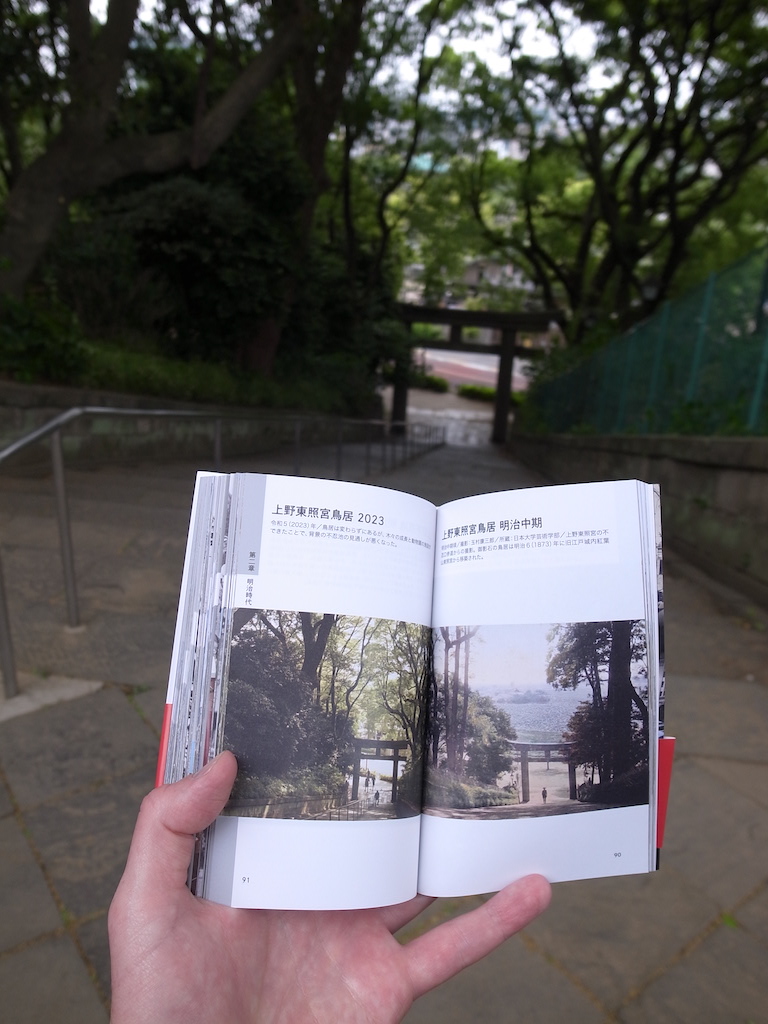
皆さんは、書店で見たことも聞いたことのない本と出会い、手放せなくなり、思いがけず購入していた、という経験はありますか? 先週、私はまさに人形町の本屋でそんな経験をしました。
本屋の入口付近に、写真家・鷹野晃氏の新刊『定点写真で見る 東京今昔』がディスプレイされていました。切手サイズの白黒写真があちこちに散りばめられたカバーデザインを見て、最初は歴史エッセイ集かと思いましたが、タイトルに目を引かれ、見本を手に取り、ランダムにページを開いてみました。
嬉しいことに、エッセイ集とはまったくの見当違いでした。これは私のライフワークのひとつである「東京リ・フォト(Re-Photo)」の本であり、ある意味「聖書」かもしれないと感じました。この本に綴じられた歴史的な物語は、言葉によってではなく、鷹野氏が丹念に探し出し、同じ視点から撮り直した、写真の相互作用によって語られているのです。値段を見るとたったの1700円(安すぎる!)。シュリンクに包まれた一冊を手に取り、急いでレジに向かいました。

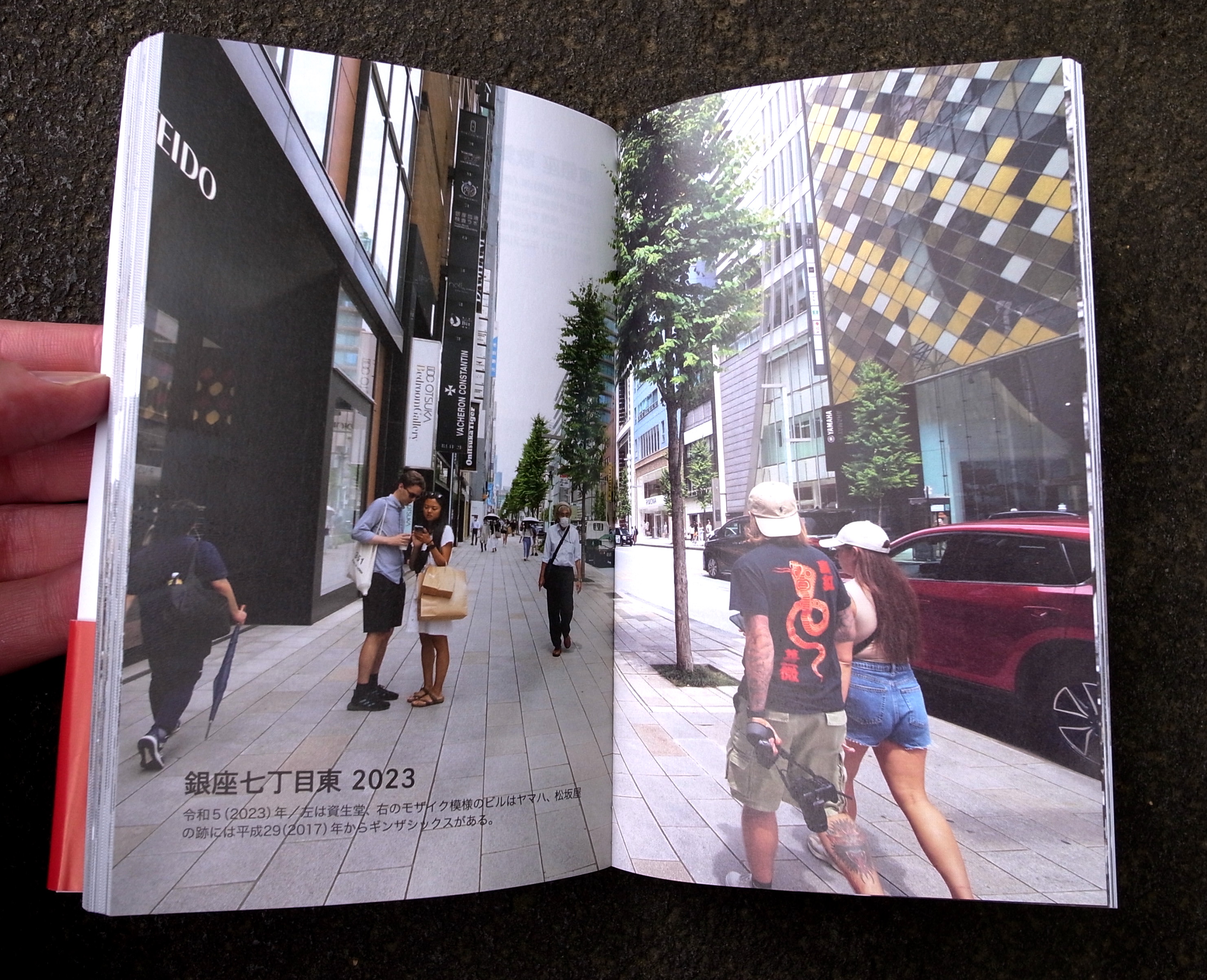
この本の中で鷹野氏は「40年間東京を撮り続けてきて、東京の魅力を表現する最良の方法は "定点写真 "だと気づいた」と述べています。「定点写真」とは、昔の写真と同じ地点(定点)から写真を撮る手法です。同じ趣味を持っている私にとって、この言葉は新鮮でした。以前から私は「リ・フォト」と呼んでいたのですが「定点写真」という響きはなかなかいいですね。
帰宅後、私はこの本と一緒に451枚の写真を1ページずつタイムトリップしながら、1時間以上を過ごしました。やっぱり魅力的な本だと感じました。この本は、鷹野氏の素晴らしい努力(リサーチ、フットワーク、レンズワーク)と、東京という街への純粋な愛情、そして写真が持つ「時間の層を覗き見る力」が組み合わさった結果の一冊なのです。
本書は年代順に5つのチャプターに分かれています。
第一章 江戸時代
第二章 明治時代
第三章 大正時代
第四章 昭和時代【戦前戦中編】
第五章 昭和時代【戦後編】
東京の歴史は、絶え間ない変化の歴史です。その要因には、激甚な破壊力を持つ地震、火災、建築物の流行、戦争の惨禍、突然の高度経済成長などが含まれます。それらの結果は、過去165年の間に何百人もの写真家たち(その多くは現在無名である)によって丹念に写ってされてきました。そういった意味で『定点写真で見る 東京今昔』は、昔の写真家たちのコラボレーションでもあるのです。
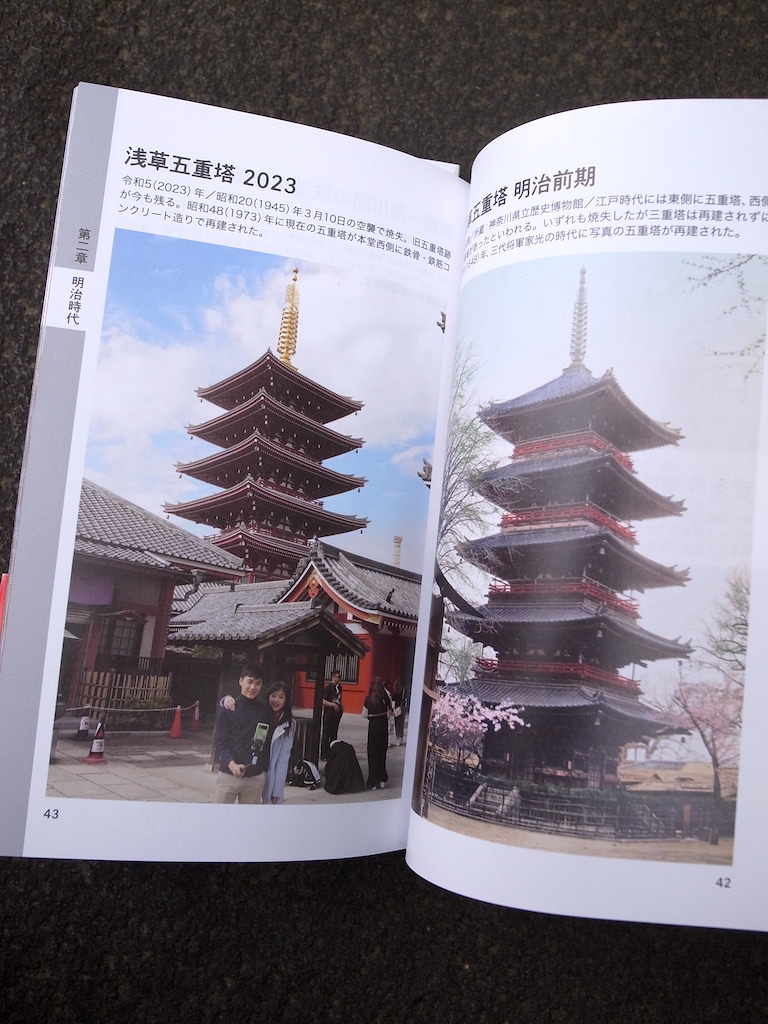
この本の魅力の多くは、タイムシフト(時間的推移)を比較するという直接的な効果によるものですが、鷹野氏自身のカメラワーク自体を、すべての読者に認めてもらいたいです。彼が捉える「今」の写真は、単に古い写真の画角と一致させた正確さの度合いを示すものではありません。多くの写真には、現代の東京に対するすこし辛辣な観察が含まれている気がします。
例えば、1910年に撮影された浅草六区での写真は、腰の高さまで浸水した男たちがカメラを振り返っています。2023年の浅草では、同じ一角にドン・キホーテの派手な店舗があり、観光客の写真をスマホで撮る人力車の引き手がにこやかに立っています。
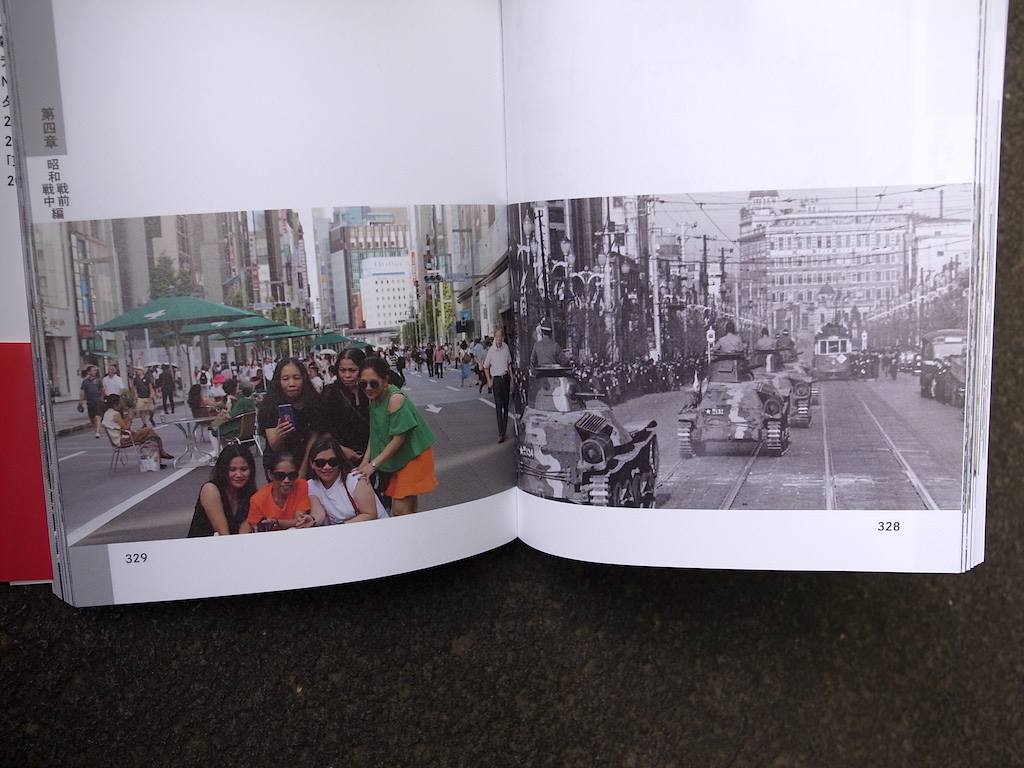
382ページでは、帝国陸軍の戦車の隊列が1942年の銀座をパレードしています。81年後、東南アジアからの観光客たちがニコニコしながら自撮りをしています。
1947年、GHQが見える視点からアメリカ占領軍のGIを写したカラー写真と、2023年、自転車で通過する際に逆ピースサインを点滅させる西洋人の写真が対になっています。
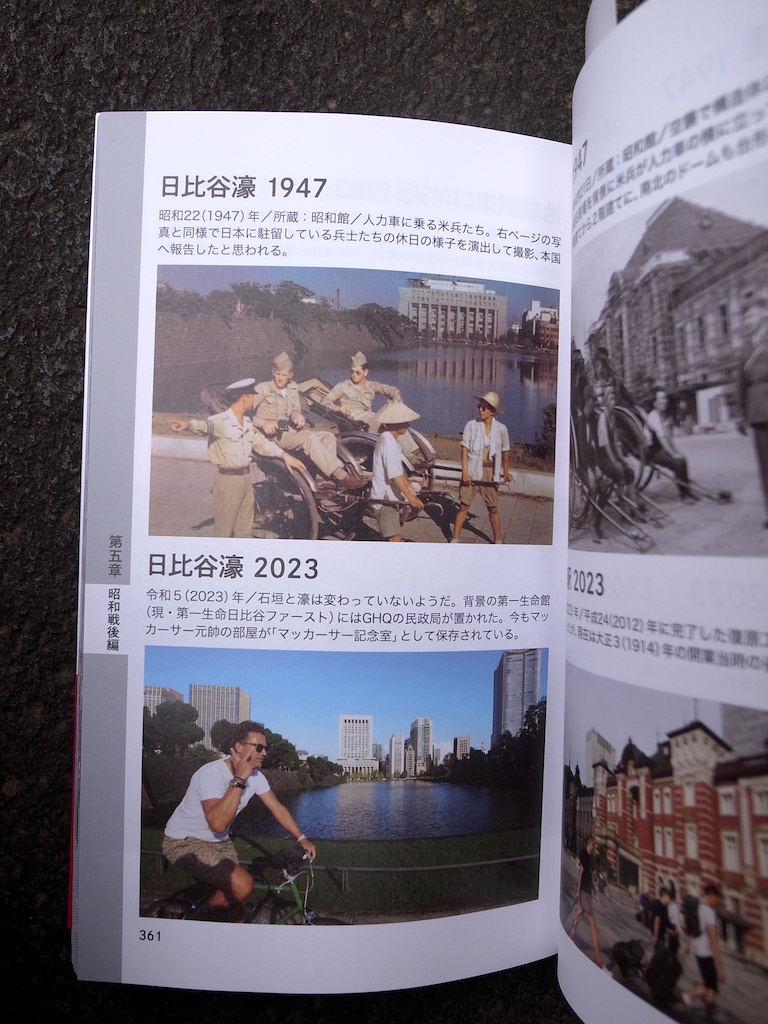
もうひとつの面白いポイントは、街の風景が変わっても、そこに住む人々の風習が変わらないことです。浅草の仲見世商店街は、いつの時代でも多くの観光客で賑わっているそうです。1910年代の神輿の担ぎ手が、100年以上経った今もその伝統を受け継ぐ子孫の姿を見たら、どれほど喜ぶだろうと、想像すると楽しくなります。
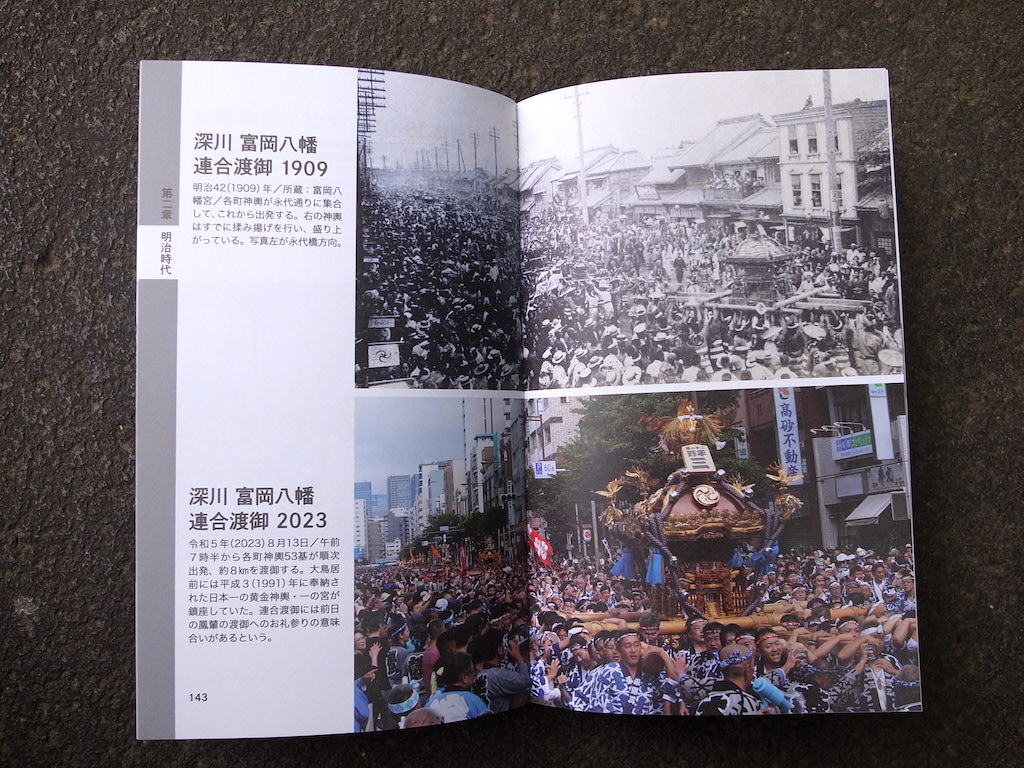
この本は450ページを超える分厚さなのですが、コートのポケットや小さなショルダーバッグにすっぽり収まるサイズです。 こうしてみると「フォトブック」より「ガイドブック」のようです。
そう、これは「地球の歩き方」ではなく「時間の歩き方」の本なのです。おすすめです!

Tokyo Now and Then: Views of the city from a fixed point.
Takano Akira
Publisher: Kobunsha, 2024
鷹野 晃『定点写真で見る 東京今昔』
発行:光文社新書
発売日:2024年3月21日
定価:1,870円(税込)


PCT Membersは、Photo & Culture, Tokyoのウェブ会員制度です。
ご登録いただくと、最新の記事更新情報・ニュースをメールマガジンでお届け、また会員限定の読者プレゼントなども実施します。
今後はさらにサービスの拡充をはかり、より魅力的でお得な内容をご提供していく予定です。
 「Photo & Culture, Tokyo」最新の更新情報や、ニュースなどをお届けメールマガジンのお届け
「Photo & Culture, Tokyo」最新の更新情報や、ニュースなどをお届けメールマガジンのお届け 書籍、写真グッズなど会員限定の読者プレゼントを実施会員限定プレゼント
書籍、写真グッズなど会員限定の読者プレゼントを実施会員限定プレゼント